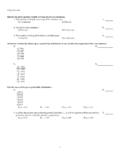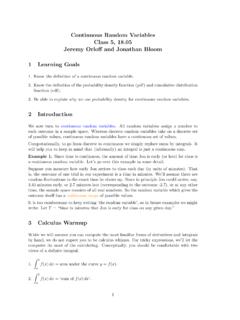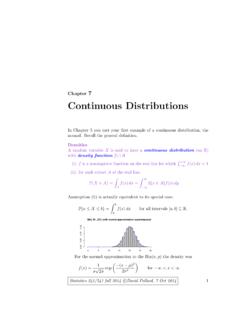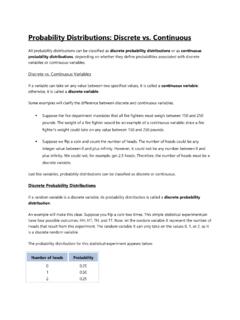Transcription of Reading 6a: Expectation, Variance and Standard Deviation ...
1 Expectation, Variance and Standard Deviation forContinuous Random VariablesClass 6, Orloff and Jonathan Bloom1 Learning Goals1. Be able to compute and interpret expectation, Variance , and Standard Deviation forcontinuous random Be able to compute and interpret quantiles for discrete and continuous random IntroductionSo far we have looked at expected value, Standard Deviation , and Variance for discreterandom variables. These summary statistics have the same meaning for continuous randomvariables: The expected value =E(X) is a measure of location or central tendency. The Standard Deviation is a measure of the spread or scale. The Variance 2= Var(X) is the square of the Standard move from discrete to continuous , we will simply replace the sums in the formulas byintegrals.
2 We will do this carefully and go through many examples in the following the last section, we will introduce another type ofsummary statistic,quantiles. You mayalready be familiar with the .5 quantile of a distribution, otherwise known as themedianor Expected value of a continuous random variableDefinition:LetXbe a continuous random variable with range [a,b] and probabilitydensity functionf(x). Theexpected valueofXis defined byE(X) = bxf(x) s see how this compares with the formula for a discrete random variable:nE(X) = xip(xi).i=1 The discrete formula says to take a weighted sum of the valuesxiofX, where the weights arethe probabilitiesp(xi). Recall thatf(x) is a probabilitydensity. Its units are prob/(unit ofX). class 6, Expectation and Variance for continuous Random Variables2 Sof(x)dxrepresents the probability thatXis in an infinitesimal range of widthdxaroundx.
3 Thus we can interpret the formula forE(X) as a weighted integral of the valuesxofX,where the weights are the probabilitiesf(x) before, the expected value is also called ExamplesLet s go through several example computations. Where the solution requires an integrationtechnique, we push the computation of the integral to the uniform(0,1). FindE(X).answer:Xhas range [0,1] and densityf(x) = 1. Therefore,E(X) = 1x2xdx=02 10= surprisingly the mean is at the midpoint of the range [0,2] and density3x2. FindE(X).8answer:E(X) = 20xf(x)dx= 2038x3dx=3x432 20= it make sense that thisXhas mean is in the right half of its range?answer:Yes. Since the probability density increases asxincreases over the range, theaverage value ofxshould be in the right half of the (x)1 = is pulled to the right of the midpoint 1 because there is more mass to the exp( ).
4 FindE(X).answer:The range ofXis [0, ) and its pdf isf(x) = e x. So (details in appendix)E(X) = x e xdx=0 xe e 0=1 .xf(x) = e x = 1/ Mean of an exponential random class 6, Expectation and Variance for continuous Random Variables3 Example N(0,1). FindE(Z).answer:The range ofZis ( , ) and its pdf is (z) =1 2e z /2. So (details in2 appendix)E(Z) = 1 2 ze z2/2dz= 1 2 e z2/2 = (z) = 0 The Standard normal distribution is symmetric and has mean Properties ofE(X)The properties ofE(X) for continuous random variables are the same as for discrete ones:1. IfXandYare random variables on a sample space thenE(X+Y) =E(X) +E(Y).(linearity I)2. Ifaandbare constants thenE(aX+b) =aE(X) +b.(linearity II)Example this example we verify that forX N( , ) we haveE(X) =.]
5 Answer:Example (4) showed that for Standard normalZ,E(Z) = 0. We could mimicthe calculation there to show thatE(X) = . Instead we will use the linearity propertiesofE(X). In the class 5 notes on manipulating random variables we showed that ifX2 N( , ) is a normal random variable we canstandardizeit:XZ= N(0 ,1).Inverting this formula we haveX= Z+ . The linearity of expected value now givesE(X) =E( Z+ ) = E(Z) + = Expectation of Functions ofXThis works exactly the same as the discrete case. ifh(x) is a function thenY=h(X) is arandom variable and E(Y) =E(h(X)) = h(x)fX(x)dx. Example exp( ). FindE(X2).answer:Using integration by parts we haveE(X2) = x2 e xdx=0[ x2e x2x e x 2 2e x] 0=2 class 6, Expectation and Variance for continuous Random Variables44 VarianceNow that we ve defined expectation for continuous random variables, the definition of vari-ance is identical to that of discrete random :LetXbe a continuous random variable with mean.
6 ThevarianceofXisVar(X) =E((X )2). Properties of VarianceThese are exactly the same as in the discrete IfXandYareindependentthen Var(X+Y) = Var(X) + Var(Y).2. For constantsaandb, Var(aX+b) =a2 Var(X). : Var(X) =E(X2) E(X)2=E(X2) Property 1, note carefully the requirement 3 gives a formula for Var(X) that is often easier to use in hand calculations. Theproofs of properties 2 and 3 are essentially identical to those in the discrete case. We willnot give them uniform(0,1). Find Var(X) and :In Example 1 we found = 1/2. Next we compute11 Var(X) =E((X )2) = (x 1/2)2dx= exp( ). Find Var(X) and :In Examples 3 and 6 we computedE(X) = 0x e xdx=1 andE(X2) = 0x2 e xdx=2. 2So by Property 3,Var(X) =E(X2) E(X)22= 2 1 2=1 2and X=1. We could have skipped Property 3 and computed this directly from Var(X) = (x 1/ )2 e N(0,1).
7 Show Var(Z) = :The notation for normal variables isX N( , 2). This is certainly suggestive, butas mathematicians we need to prove thatE(X) = and Var(X) = 2. Above we showedE(X) = . This example shows that Var(Z) = 1, just as the notation suggests. In the nextexample we ll show Var(X) = :SinceE(Z) = 0, we haveVar(Z) =E(Z21) = 2 z2e z2/2dz. class 6, Expectation and Variance for continuous Random Variables522(using integration by parts withu=z, v =ze z /2 u = 1, v= e z /2)1= 2 ( ze z2/2 )+1 2 e z2/2dz. The first term equals 0 because the exponential goes to zero much faster thanzgrows atboth . The second term equals 1 because it is exactly the total probability integral ofthe pdf (z) for N(0,1). So Var(X) = N( , 2). Show Var(X) = :This is an exercise in change of variables.
8 Lettingz= (x )/ , we haveVar(X) =E((X )21) = 2 (x )2e (x )2/2 2dx= 2 /2 2z2e z2dz= 2. The integral in the last line is the same one we computed for Var(Z).5 QuantilesDefinition: ThemedianofXis the valuexfor whichP(X x) = , the valueofxsuch thatP(X X) =P(X x). In other words,Xhas equal probability ofbeing above or below the median, and each probability is therefore 1/2. In terms of thecdfF(x) =P(X x), we can equivalently define the median as the valuexsatisfyingF(x) = :What is the median ofZ?answer:By symmetry, the median is the median ofX exp( ).answer:The cdf ofXisF(x) = 1 e x. So the median is the value ofxfor whichF(x) = 1 e x= Solving forxwe find:x= (ln 2)/ .Think:In this case the median does not equal the mean of = 1/.
9 Based on the graphof the pdf ofXcan you argue why the median is to the left of the : ThepthquantileofXis the valueqpsuch thatP(X qp) = In this notation the median We will usually write this in terms of the cdf:F(qp) = respect to the pdff(x), the quantileqpis the value such that there is an area ofptothe left ofqpand an area of 1 pto the right ofqp. In the examples below, note how wecan represent the quantile graphically using either area of the pdf or height of the the quantile forX U(0,1). class 6, Expectation and Variance for continuous Random Variables6answer:The cdf forXisF(x) =xon the range [0,1]. (x) tail area = prob = (x) ( ) = : left tail area= F( ) = the quantile of the Standard normal :We don t have a formula for the cdf, so we use the R quantile function ( , 0, 1)= (z) tail area = prob.
10 = .6z (z) ( ) = : left tail area= F( ) = give a useful measure oflocationfor a random variable. We will use them morein coming Percentiles, deciles, quartilesFor convenience, quantiles are often described in terms of percentiles, deciles or 60thpercentileis the same as the quantile. For example you are in the 60thpercentilefor height if you are taller than 60 percent of the population, theprobabilitythat youare taller than a randomly chosen person is 60 ,decilesrepresent steps of 1/10. The third decile is the steps of 1/4. The third quartile is the quantile and the Appendix: Integral Computation DetailsExample 3:LetX exp( ). FindE(X).The range ofXis [0, ) and its pdf isf(x) = e x. ThereforeE(X) = xf(x)dx=0 xe class 6, Expectation and Variance for continuous Random Variables7(using integration by parts withu=x,v = e x u = 1,v= e x)= xe x +e xdx00e x = 0 0=1.]
















